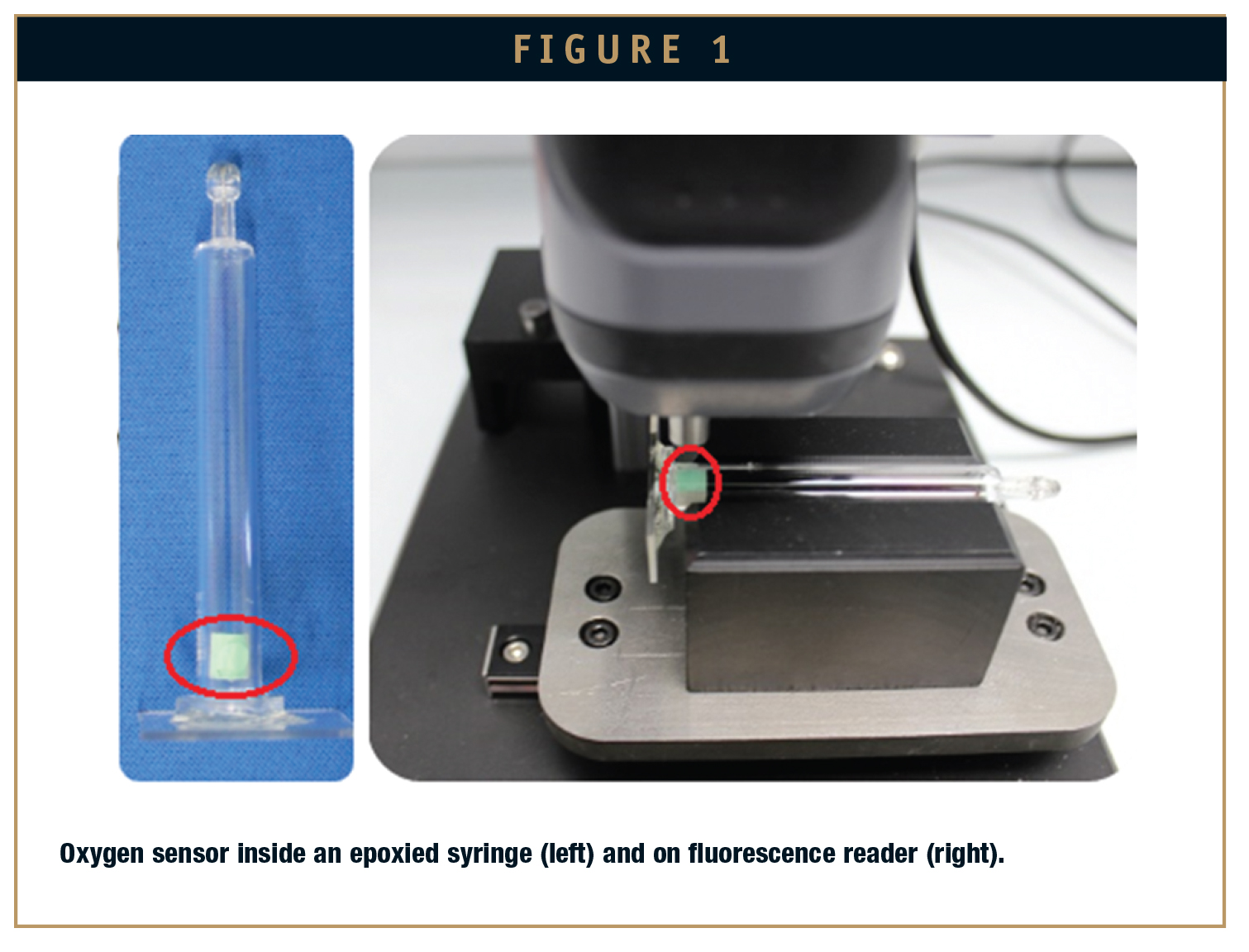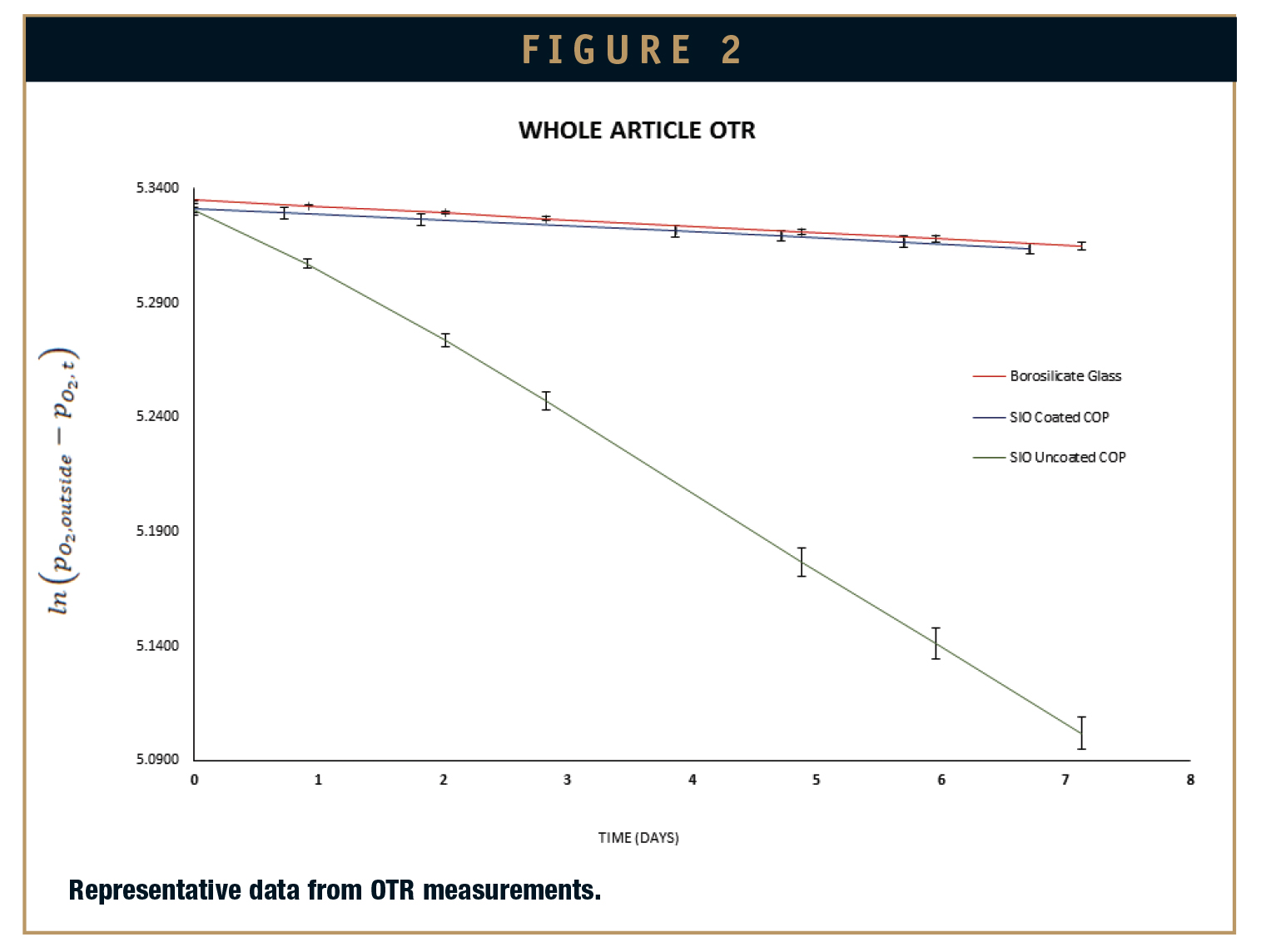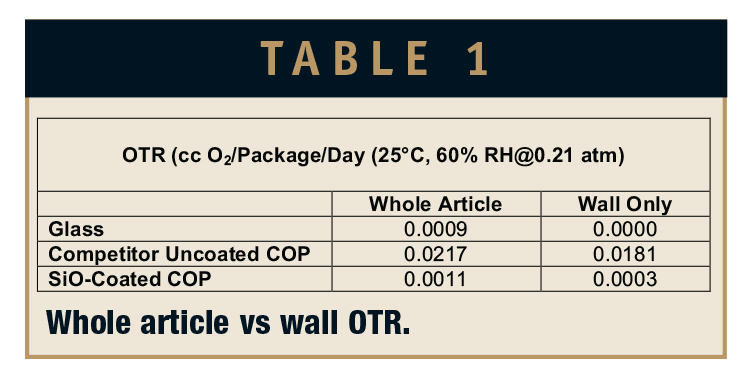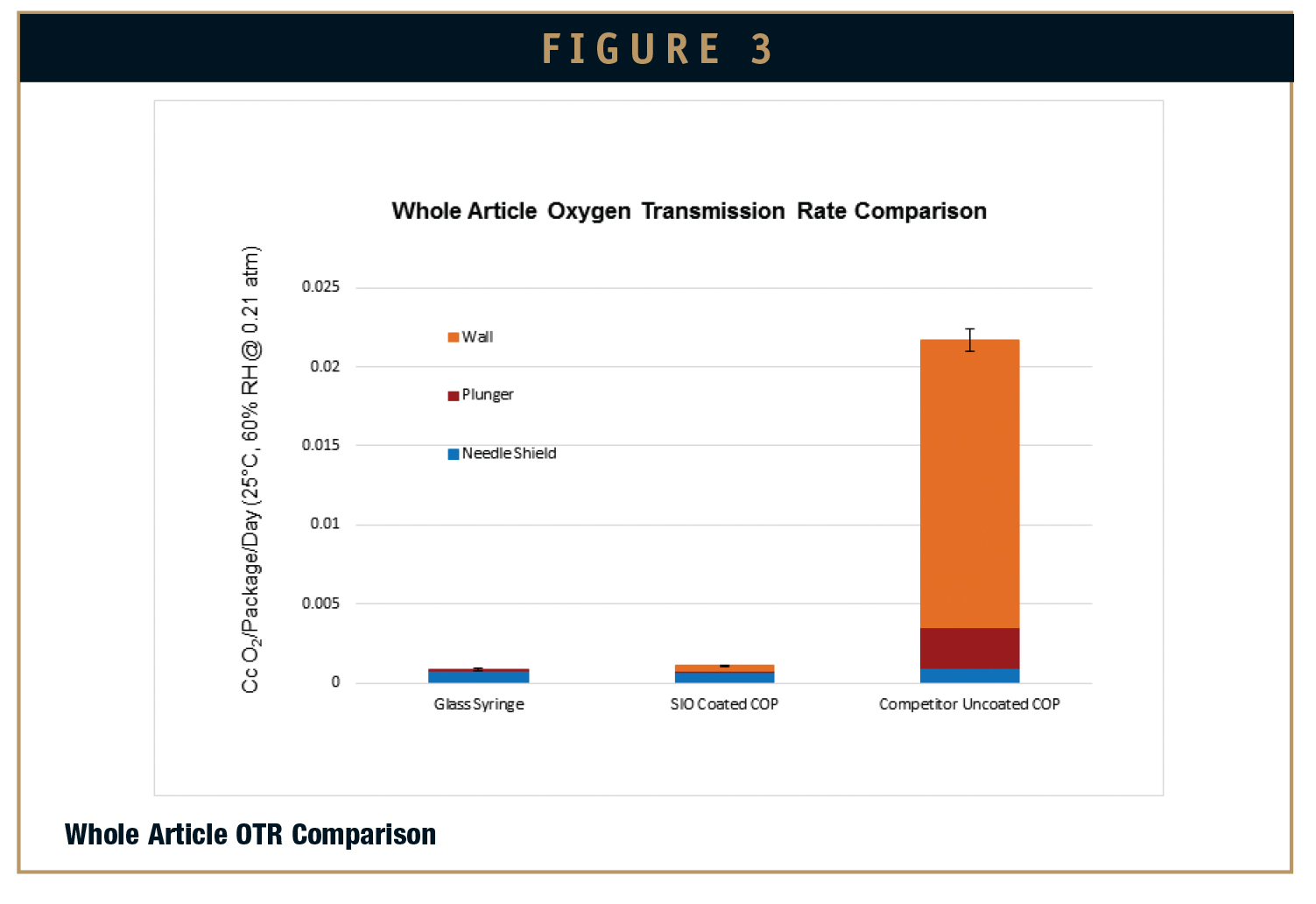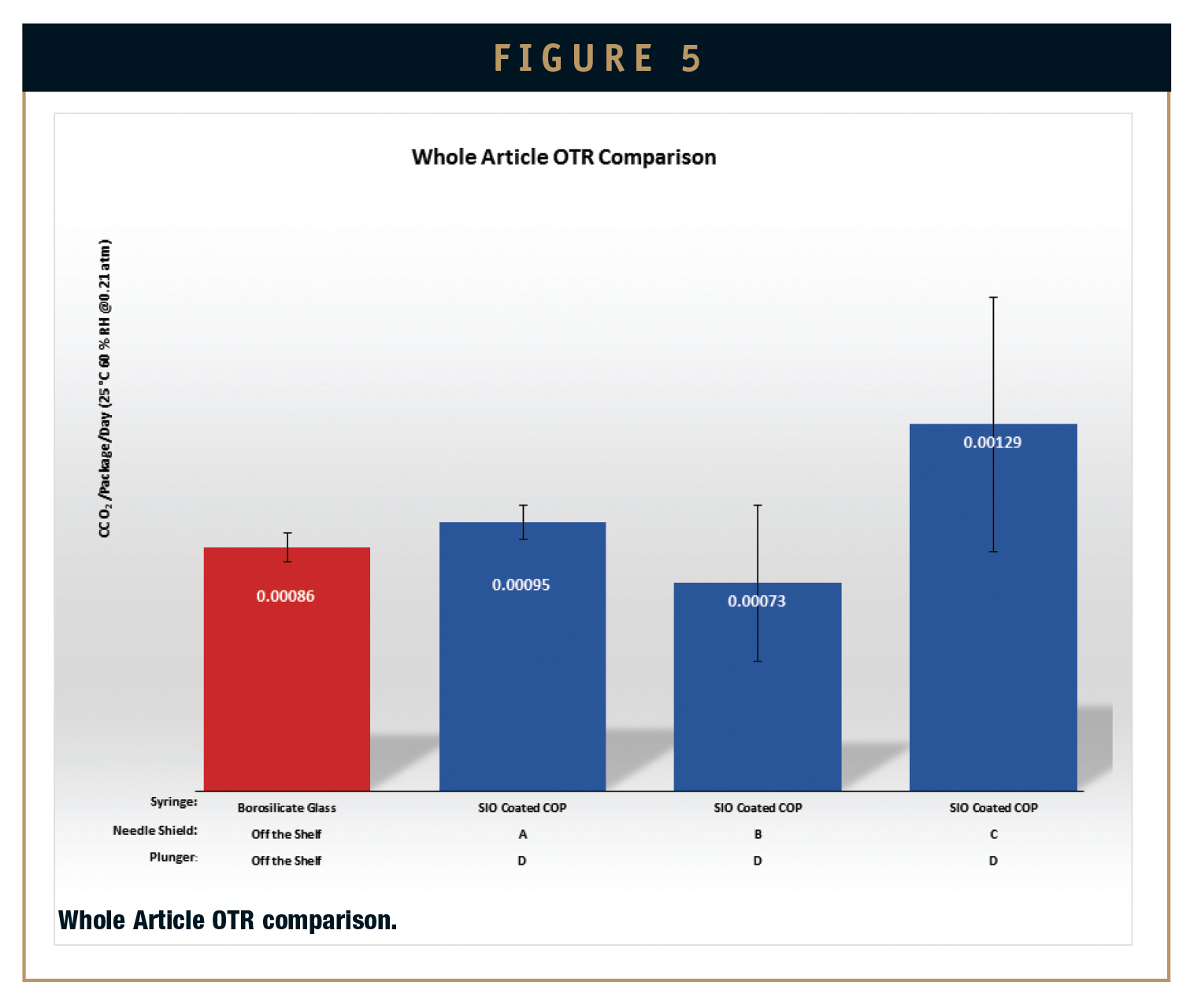Issue:September 2014
PARENTERAL CONTAINERS - A Novel Approach to Mitigating Oxygen Permeation in Prefilled Syringes
SiO₂ Medical Products (SiO) is a vertically integrated manufacturer of primary containers. Using advanced materials science, SiO has developed a line of parenteral drug containers that offer improved performance and consistency over existing containers. SiO’s containers are precision-molded from medical-grade plastics, and the interior surface has a thin, transparent, silicon-oxide based coating system. Our containers combine the durability of plastic with the high-purity and barrier properties of glass, while eliminating the shortcomings of existing glass and plastic containers.
INTRODUCTION
Parenteral drug containers are multicomponent systems designed to safely store a drug until it is ready for administration to the patient. Historically, parenteral drugs are first launched in vials, with subsequent development of prefilled delivery options. Recent trends in the industry, however, show an increase in the use of prefilled syringes as the primary container of choice.1 There are several factors to consider when selecting the components for a drug delivery system, such as the nature of the active pharmaceutical ingredient (API) (eg, molecule size and complexity), oxygen sensitivity, formulation pH, cytotoxicity, and stability, among others. In this article, we will focus on oxygen permeation into a sealed syringe and detail how the individual system components (syringe, needle shield, and plunger) contribute to the overall Oxygen Transmission Rate (OTR). Whole article testing refers to an experimental design in which the OTR of a fully assembled syringe is measured, mimicking the environment that a drug product would be subject to in a prefilled, ready-to-use syringe. Glass has historically been the material of choice for the syringe, and while glass provides an excellent oxygen barrier, other factors should also be taken into account when selecting components for a prefilled syringe system. More complex formulations reaching the market today, such as proteins, monoclonal antibodies (mAbs), and other biologics can have compatibility issues with the silicone oil that must be used to provide lubricity for glass. Oxygen ingress is not limited to the syringe wall; the other components of the prefilled syringe (the plunger and needle shield) also contribute. SiO offers an alternative to traditional glass primary packaging, namely cyclic olefin polymer (COP) parenteral containers with an internal coating of pure silicon oxide providing glass-like oxygen barrier properties.2 As part of a Quality-by-Design (QbD)-driven development process, SiO has developed a means for quantitatively measuring oxygen ingress into prefilled syringes, and furthermore, we are able to measure the OTR contribution from the individual components (barrel wall, plunger, and needle shield).
UNDERSTANDING THE NEEDS OF THE PRODUCT
Understanding the nature and requirements of the drug product is a key step in designing a prefilled syringe system. Every drug product has unique needs to be met. At a basic level, a container must protect the API purity and stability. Accelerated stability testing and forced degradation studies of the API/drug product will reveal potential liabilities for the drug that must be considered. Borosilicate glass is a material with a long track record in parenteral containers; however, it has many disadvantages, such as the potential for breakage and a high count of visible particles, which have led to costly recalls. Newer formulations reaching the market now, such as proteins, monoclonal antibodies, etc., have complex requirements, such as higher sensitivity to silicone oil and aggregation from high particle counts, thus requiring a more cautious approach. For purposes of this discussion, we will focus on understanding drug product oxygen sensitivity and controlling oxygen ingress into the prefilled syringe. Forced degradation and early accelerated stability studies should provide the development team an indication of the areas of concern for API stability, including oxygen sensitivity. Once an initial basic understanding of the API sensitivity to oxygen is obtained, there are several approaches that can be taken to further understand the oxygen sensitivity and determine the maximum allowed oxygen ingress into the prefilled syringe system (ie, not adversely affect the drug product). A quantitative approach can be taken that involves stability testing of the API at various O2 partial pressures and determination of the rate of oxidation. A complete discussion of this approach; however, is outside of the scope of this discussion. A more general approximation could be determined by placing the API/formulation in an oxygen-enriched environment and submitting it to accelerated conditions (eg, 40°C/75% RH). This approach should provide the development team enough information to select candidates for the optimal container. At a basic level, the oxygen sensitivity of the API will be categorized as none, slight sensitivity, or high sensitivity.
RATIONAL CONTAINER DESIGN
The understanding of the drug product needs gained by early stability and degradation studies will allow for a rational approach to container design in which individual components are selected according to how they meet those needs. Prefilled syringes have the advantage of delivering an accurate dosage to the patient in a safer, easy-to-use format; to do so, they have to be sterilizable, maintain CCI, protect the drug product from possible extractables and leachables from the container (labels, adhesives), and also provide some protection against breakage. Depending on the nature of the API, some concerns (such as breakage in the case of cytotoxic drugs) can be of greater importance than others.3 Components should be selected that address the specific needs of the drug product. This discussion focuses on whole article oxygen permeability and, therefore, we need to consider the oxygen permeability characteristics of the syringe wall, plunger, and needle shield. Other more general considerations are outside the scope of this article.4
The OTR is determined using an optical oxygen analyzer. The Mocon system uses an optical sensor containing a platinum metal complex that fluoresces directly proportionally to the amount of oxygen present in the environment. Working in an oxygen-depleted environment, the oxygen sensor is placed in the container to be tested, and the container is then sealed using an epoxied glass slide. The samples are then exposed to standard atmospheric conditions at room temperature, and the fluorescent quenching of the metal complex, specific to oxygen, is measured non-destructively over time to determine the increase in the concentration of oxygen in the test article. The ingress of oxygen is measured daily for a week or longer. In the early stages of container optimization, only the coated wall area was tested for OTR, excluding contributions of the needle shield and plunger. Once our development process achieved consistent oxygen-barrier properties along the wall, comparative studies were performed on a variety of whole article assemblies to evaluate SiO’s performance relative to that of other commercially available products. The differential in the observed OTR, when testing whole articles, led to the determination of the individual contributions of each component (ie, plungers and needle shields) to demonstrate the additive effect of each component to the whole article OTR.
CALCULATIONS
The OTR into a whole article syringe at a given time t is given by:
Where V is the syringe internal volume, Pwa is the whole article permeation coefficient (moles time-1 pressure-1), p02,outside is the oxygen partial pressure outside the container, p02,t is the oxygen partial pressure inside the container at a particular time t, T is the absolute temperature, and R is the gas constant. The whole article permeation coefficient is dependent on the syringe component permeation characteristics and syringe geometry:
Where A is the syringe wall area, Pwall is the average permeance of the wall (moles time-1 wall area-1 pressure-1), Pp is the plunger permeation coefficient (moles time-1 pressure-1), and Pns is the needle shield permeation coefficient. On integration of the rate equation:
Where p02,0 is the oxygen partial pressure in the container at time zero (typically near zero). Plots of In (p02,outside – p02-t ) vs t should be linear with a slope for the whole article (time-1):
The whole article permeation coefficient (moles time-1 pressure-1) calculated from this slope is the key experimentally determined value from the measurement. From the permeation coefficient, the OTR can be determined and then converted to any unit desired. In an effort to standardize, the units cc/package/day, including the measurement conditions, were chosen.
DISCUSSION
Once a drug product reaches the level of development when the primary container selection process begins, the development team should have some understanding of the drug product sensitivity requirements. For purposes of this article, we will focus solely on oxygen sensitivity. The team will be faced with a number of options regarding the choice of wall materials because in response to market requirements, manufacturers have developed new syringe wall materials that offer alternatives to glass. We will focus our discussion on a comparison of the oxygen-permeance properties of glass, uncoated COP, and coated COP containers from SiO. Whole article OTR measurements show that uncoated COP syringes are at a clear disadvantage when compared to glass (Table 1) due to the oxygen permeability of COP. SiO-coated COP syringes show much lower OTR compared to uncoated COP due to the unique internal barrier coating that gives the syringes glass-like properties. However, when we look at the oxygen permeance from the wall alone, it is evident that the wall contribution is not the major contributing factor to oxygen ingress.
A detailed analysis (Figure 3) shows the individual component contributions to oxygen ingress: the data shows that for glass and SiO-coated COP syringes, the component with the greater contribution to oxygen permeance is the needle shield. Contributions from the wall and plunger are minimal in comparison (Figure 4).
Container closure components and their assembly have an effect on whole article OTR. Figure 5 demonstrates that OTR varies with needle shields using a coated COP syringe barrel. Additionally, a reference value for a purchased commercial glass syringe system is shown. The selection of appropriate closure parts can allow whole article SiO parts to approach glass syringes, and in one example, yield an even lower oxygen ingress. With rational design and selection of components, coated COP syringes can protect oxygen-labile drug products. The data shown in Figure 5 was produced using a single condition and was not optimized for closure part assembly. Thus, the observed variability in the data is a combination of the needle shield design, assembly conditions, and elastomer properties.
CONCLUSION
With biological systems entering the market place at an increased rate, oxidation sensitivity is an issue that will need to be considered further. The novel materials with improved performance entering the marketplace offer a new variety of options that should be examined and understood by development teams. In this article, we have focused on designing a primary container system (prefilled syringe) for the minimization of oxygen exposure to the drug product. Initial stability studies will provide the formulation team an idea of how sensitive the drug product is to oxidation, and this should be taken into account when selecting a container for the drug product. The oxygen contributions from the various components available need to be accounted for – simply choosing a wall material that is impermeable does not ensure good oxygen inertness. The oxygen permeability of COP-molded syringes for use as prefilled syringes has been investigated at the whole article and the individual component level. With a more thorough understanding of the individual contributions to OTR, a rational approach can be taken to designing a container system that meets the needs of the API. We have demonstrated that the COP syringes from SiO (coated with an internal barrier liner) offer oxygen permeation characteristics that are glass-like. Furthermore, once the OTR for whole article coated is taken into consideration, COP syringes from SiO can approach (and in one case surpass) the oxygen permeation of glass prefilled syringes. The new coated COP syringes from SiO offer the advantages of plastic containers (resistance to breakage, more precise molding, and low particulates) along with the advantages of glass (good gas impermeability, chemical resistance, no organic extractables). Utilizing QbD principles, SiO2 Medical Products has developed a process that produces superior products through our leading-edge technology, superior quality, and consistent product performance.
To view this issue and all back issues online, please visit www.drug-dev.com.
REFERENCES
1. Romacker M, Schoenknecht T, Forster R. The Rise of Prefilled Syringes from Niche Product to Primary Container of Choice: a Short Story. ONdrugDelivery Magazine. Prefilled Syringes: the Container of Choice for Today’s Injectables 2008; Issue 14:4-5.
2. Kinney S, Weikart C, Sagona P. Part II of II: Improved Parenteral Containers Through Plasma Deposition of High Purity Glass. ONdrugDelivery Magazine. 2014; Issue 47:18-22.
3. McLauchlan R, et al. Responsibilities of Manufacturers of Cytotoxic Drugs, Standards Committee, International Society of Oncology Pharmacy Practitioners (ISOPP). Touch Briefings (Jan 2010).
4. Wagner A. Parenteral Packaging Considerations. Contract Pharma. (April 2012). Website: http://www.contractpharma.com/issues/201204/view_features/parenteralpackag ng-considerations/

Peter Sagona is Senior Vice President at SiO2 Medical Products, responsible for program management, including overall project coordination of deliverables and timelines. Mr. Sagona also oversees the intellectual property strategy associated with the program. Prior to joining SiO, Mr. Sagona spent 11 years with CV Holdings LLC, and 7 years at SmithKline Beecham Clinical Laboratories managing automation development projects. Mr. Sagona earned his MS in Engineering Management from Drexel University.

Rómulo Romero is a Senior Applications Scientist at SiO2 Medical Products and an analytical chemist with over 15 years of experience supporting the pharmaceutical discovery. Mr. Romero earned his MS in Organic Chemistry from Florida State University. He was with Bayer Pharmaceutical in West Haven, CT, for 13 years supporting medicinal chemistry by solving purification challenges, and previously with Neurogen Corporation in Analytical Development and Merck in Boston, carrying out purifications of compound libraries and learning SFC.
Adam Breeland is an Analytical Chemist at SiO2 Medical Products, responsible for method development and validation, writing test methods, and training lab technicians. He collaborates with internal engineers and consultants on a variety of new product development projects as well as existing product enhancements aiding in experimental design and test output matrices. Mr. Breeland earned his BS in Chemistry from Millsaps College.
Total Page Views: 5646





